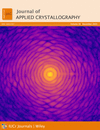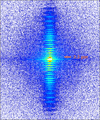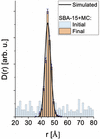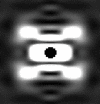issue contents
Small-angle scattering special issue (December 2023)
Edited by Florian Meneau, Jill Trewhella and Jan Ilavsky
The articles in this virtual special issue represent some highlights of the 18th International Small Angle Scattering Conference (SAS2022).

Cover illustration: Coherent small-angle X-ray scattering pattern of a zeolite crystal collected at the Cateretê beamline at Sirius, Brazil.
Open  access
access
 access
accessA new virtual special issue highlights some of the most exciting work presented at the 18th International Small Angle Scattering Conference (SAS2022), which took place in Campinas, Brazil. The articles included here were originally published in recent regular issues of Journal of Applied Crystallography and Acta Crystallographica Section D. The SAS2022 special issue is available at http://journals.iucr.org/special_issues/2023/sas2022/.
Open  access
access
 access
accessSelected recent advances in small-angle X-ray and neutron scattering are highlighted, together with some of the hard material applications they serve in the areas of manufacturing, energy and climate change. This paper is associated with work presented at the 18th International Conference on Small-Angle Scattering, Campinas, Brazil, September 2022 (SAS 2022).
Open  access
access
 access
accessThis article presents some representative examples illustrating the performance of small-angle X-ray scattering and X-ray photon correlation spectroscopy methods with the Extremely Brilliant Source at the European Synchrotron Radiation Facility.
Details of the microstructures in soft-matter systems and their evolution following a change in environment can be revealed by combining in situ X-ray scattering data with two-dimensional correlation spectroscopy.
Open  access
access
 access
accessThis publication describes the stable version of a liquid chromatography system combined with the small-angle neutron scattering (SANS) instrument D22 at Institut Laue–Langevin to run size-exclusion chromatography (SEC) immediately before SANS measurement.
Open  access
access
 access
accessAn updated template reporting table based on the 2017 publication guidelines for biomolecular SAS and 3D modelling is presented that includes standard descriptions for proteins, glycosylated proteins, DNA and RNA, and some reorganization of the data to improve readability and interpretation. A specialized template has also been developed for reporting SAS contrast-variation data and models that incorporates the additional reporting requirements for these more complicated experiments.
Open  access
access
 access
accessA rapid ensemble modelling method that optimizes the fit to the small-angle X-ray scattering (SAXS)-derived pair-wise distance distribution function [P(r) versus r] and the measured intensity profile [I(q) versus q] has been used to account for differences between AlphaFold-predicted and experimental SAXS profiles. By considering the confidence levels that come with the predicted structures, a conformational ensemble with potentially flexible linkers between stable folded domains can be optimized to provide representative structures.
Open  access
access
 access
accessSmall- and wide-angle X-ray scattering and asymmetric flow field-flow fractionation integrated with multi-angle light scattering (AF4–MALS) are used to characterize PEGylated liposomes of hydrogenated soy phosphatidylcholine (HSPC) that have potential for drug delivery. Observed local and global structural changes of the phospholipid bilayers reveal the effects of cholesterol on PEGylated HSPC liposomes.
Open  access
access
 access
accessA systematic investigation on alterations promoted by acid straightening and/or bleaching in hair microstructures is presented. By combining X-ray scattering methods and microcomputed tomography, among several other methods, innovative results were obtained on the structure and thermodynamics of human hair subjected to cosmetic procedures.
Open  access
access
 access
accessSilica-rich sedimentary rocks (chert) exhibit an evolving microstructure able to preserve organic matter mostly in mesopores during geological timescales. Under compaction, silica porous matrices experience porosity reduction, dehydration of silica and redistribution of organics inside the pore network.
Small-angle neutron scattering is used to characterize the microstructural changes in building materials treated by various specialist consolidating agents.
Open  access
access
 access
accessThis study examines the time evolution of microscopic structure in a model industrial process, a sol of gel-initiated silica particles in a simple Couette shear field, using small-angle neutron scattering SANS) and ultra-small-angle neutron scattering (USANS) over a large range of scattering vector magnitudes/length scales. Comparison of the experimentally derived parameters with a simple theoretical model provides additional insight.
Open  access
access
 access
accessIn situ small-angle X-ray scattering was used to identify structural changes during thermal treatment of an ordered mesoporous carbon precursor material, synthesized via direct soft templating, to remove Pluronic F127 surfactant from a resorcinol–formaldehyde frame.
Open  access
access
 access
accessThe new model proposed in this work allows retrieval of the mesopore size distribution of SBA-15 (and similar ordered mesoporous materials) from small-angle X-ray scattering data using a free modelling approach. According to the obtained results, even more complex size distributions can be recovered, such as the case of SBA-15 with expanded mesopores.
A novel methodology using solely small-angle X-ray scattering (SAXS) measurements at multiple temperatures is proposed to determine the coefficients of thermal expansion of confined spherical nanocrystals and/or nanodroplets and the radius dependence of the melting temperature of spherical nanocrystals.
Open  access
access
 access
accessSemi-crystalline polymers present a hierarchical organization of structural levels from ångströms to hundreds of nanometres. By combining small- and wide-angle neutron scattering at the same instrument, such complex morphologies can be resolved under application of relevant humidity and temperature conditions.
Open  access
access
 access
accessUse of the double-gating mode implemented on the modern hybrid photon counting system EIGER2 helps to suppress the influence of beam fluctuations in pump–probe experiments at synchrotron radiation facilities and provides better data quality.
Open  access
access
 access
accessA novel biaxial tensile tester designed to work in combination with 2D synchrotron-based scanning small- and wide-angle X-ray scattering and digital image correlation is described. The available biaxial modes and a proposed sample geometry are discussed.
Open  access
access
 access
accessShape2SAS allows the user to simulate solution small-angle scattering data and pair distance distributions from user-defined shapes. The program is available as a web application, and is useful for teaching and tutorials, as well as for checking the validity of analytical form factors.
Open  access
access
 access
accessAn upgrade to the D+ software is presented, simulating the 2D scattering pattern from structures with a single orientation or fibers. An upgraded independent D+ Python API is described, including structure factor, polydispersity and several other features.

 menu
menu



































